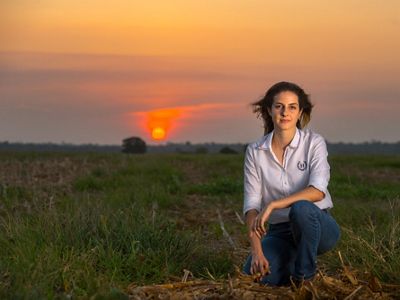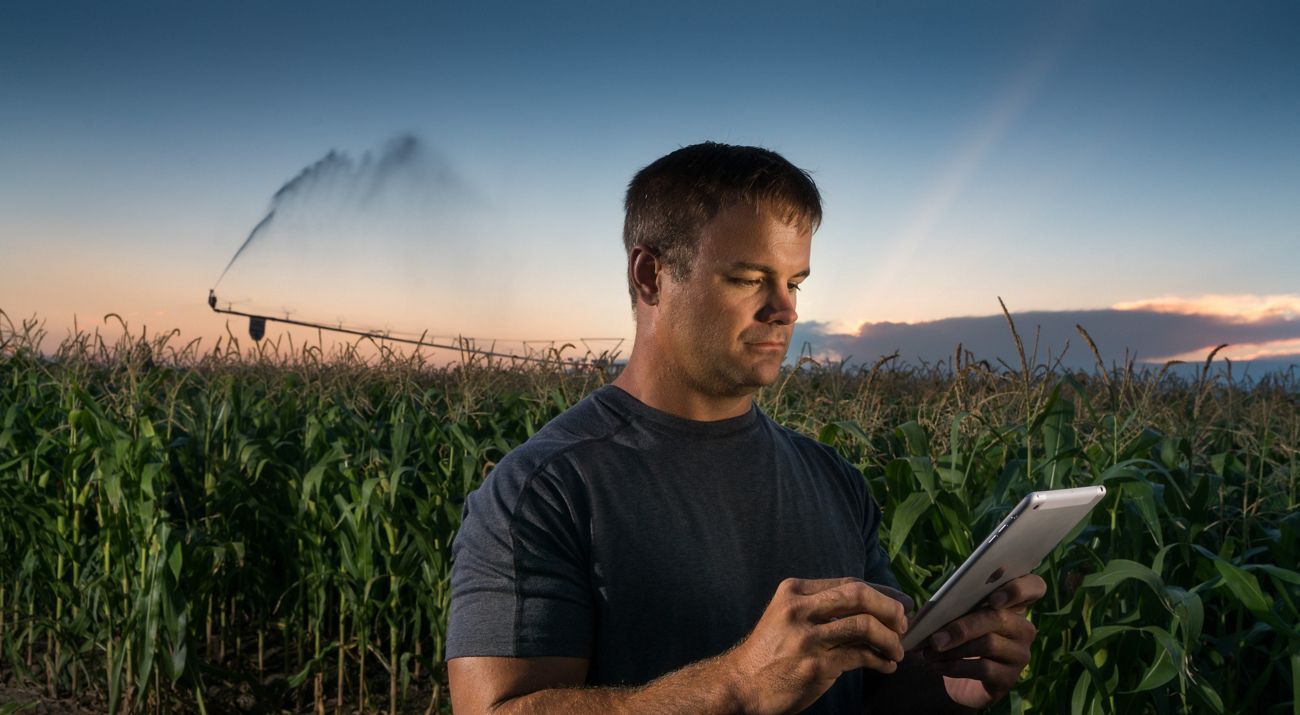Smart Growth
Farmers and scientists are working together to grow more food while minimizing demands on land and water.
Spring 2018
In western Nebraska, where Mike Svoboda grows 2,400 acres of kidney beans, black beans and popcorn, water is a farmer’s most precious resource. Farmers draw water from the nearby South Platte River and pump groundwater from the Ogallala Aquifer.
Yet farmers’ dependence on water has come at a cost to the environment. A 90-mile stretch of the Platte has been designated as critical habitat to protect endangered whooping cranes, and many farmers who depend on the Ogallala are being forced to limit their pumping to prevent aquifer levels from falling too fast.
In 2014, The Nature Conservancy began a pilot program to increase water efficiency here, eventually partnering with almost a dozen farmers who account for some 8,000 acres of land. Since then, Svoboda says, “it saved a lot more water than anybody had anticipated.”
The program helped the farmers learn to micromanage irrigation across their fields, enabling them to reduce their pumping by about 20 percent. Over the three-year period, they saved more than a billion gallons of water—enough to fill more than 110,000 semitanker trucks. That’s good for the environment, but it is also good for farmers’ bottom lines. Pumping water takes a lot of energy, so reducing pumping saves money. But the study had another interesting result: Less water didn’t equal smaller harvest yields. “We had two fields that were almost identical, except that one had all the water-efficiency technology on it,” says Svoboda. At harvest time, he says, “that one kicked the other field’s butt.”
When it comes to farming, doing more with less—not just in Nebraska but across the globe—is more critical than ever. According to the United Nations, by 2050 an estimated 9.8 billion people will live on the planet. That’s a 29 percent increase over today’s population, but it also represents only part of the demand on farmers. To keep pace with rising standards of living and richer tastes, scientists and the UN estimate that the global food supply will actually have to increase by 40 to 50 percent.
That could take a huge toll on the environment, in terms of both water and land. Traditionally, the way to grow more food has been to expand farmland—often by cutting down forests or converting grasslands and other natural habitats. Increasing food production simply by expanding the amount of land farmed and grazed with current techniques would require opening up an area the size of South America.
Yet a relatively new concept may offer a better way forward. “Sustainable intensification”—producing the same amount or more while using fewer natural resources such as land and water—could help farmers and ranchers meet the growing global demand for food while avoiding the destruction of forests and other important wildlife habitat.
Scientists have been exploring the possibility that farmers might be able to increase their yields for years without harming the environment, and the term sustainable intensification emerged in the early 1990s. “It was a discussion that was, for several years, bubbling away in the academy,” says David Cleary, TNC’s global director of agriculture.
Now, TNC is working to show that sustainable intensification has real legs, and the organization has made it a pillar of its global agriculture strategy. Cleary is quick to point out that this “is not a license to just press the intensification accelerator pedal everywhere. There are plenty of places that are already up against the limits of how far you can intensify without deep, negative environmental impacts.”
The trick is figuring out how to mold the concept to local realities. There is no set recipe for sustainable intensification. The strategy starts with determining a locale’s most at-risk natural resources.
In Nebraska, that was water. “Nebraska has more acres of irrigated cropland than any other state in the country,” says Mace Hack, TNC’s Nebraska state director. “Irrigation sustains our agriculture.”
In 2014, the Western Nebraska Irrigation Project began by mapping the relative productivity of different parts of each field with a sensor-laden “sled.” That, Svoboda says, helped open his eyes to the relative differences between each of his 18 fields. “Each piece of property is like its own living thing,” he says, “and they all behave differently.”
The field mapping creates the foundation for several water efficiency measures. “That ‘bitmap’ of your field,” says Hack, “becomes the basis by which you can start optimizing the rest of your system.” Soil sensors relay exact information about moisture levels, allowing farmers to more intelligently manage the water they use. And telemetry packages allow farmers to control their center-pivot irrigation systems via smartphone, shutting the systems off when it rains, for example.
But more precise irrigation and fertilization techniques—fertilizer is often applied through the irrigation system—also provided direct benefits to farmers in terms of what Svoboda calls “the yield bump.” He says he saw a roughly 8 percent increase in yield at the same time he was pumping 20 percent less water. “When you see the yield bump,” he says, “you’re like, ‘Why haven’t we been doing this for years?’”
Next year, the Midwest Row Crop Collaborative will begin working with another group of farmers representing a much larger area downstream on the Platte River to increase their water efficiency. Ultimately, TNC aims to help improve water efficiency on half of all the irrigated acres in Nebraska.

In Brazil, however, forests are the natural resource under greatest threat. The country is the world’s second-biggest producer of both beef and soy after the United States, and it has been a proving ground for TNC’s sustainable intensification work. Production has grown there since the mid-1990s, in response to growing global demand. But farm and ranchland expansion was contributing to the loss of millions of acres of Amazon forest.
Pressure from environmental groups led to a voluntary moratorium that took effect in 2006, under which soy traders such as Cargill, ADM and Bunge pledged not to purchase soy grown on deforested land. “That,” Cleary says, “forced soy to expand over land that’s already been cleared.” There’s no shortage of such land, primarily in the form of millions of acres of former cattle pasture.
In the years since, TNC has been working with Cargill in north-central Para state, around the city of Santarem, to ensure that soy production is channeled into the areas where it will cause the least environmental impact to the Amazon.
The Conservancy and local partners use satellite imagery to identify areas where deforestation is continuing to occur and farmers who grow on newly cleared land.
Mariana Menoli’s parents were farmers who arrived in the Santarem area 20 years ago, a few years before a large wave of soy farmers moved in. The Menolis were among the first to work with TNC and the soy supply chain to ensure that any growth of their farm complied with deforestation laws.
“Brazilian environmental law was very complex, so it was difficult to apply it in the field,” says Menoli, who is a partner of her family’s farm. “The Nature Conservancy helps us to better understand the legislation and meet compliance requirements, and it offers training to producers and farm hands about good agriculture practices.”
Conservancy staff have also advised her family on strategies to restore degraded areas for better harvests. Besides soy, the Menolis alternate raising rice, corn and cattle on their fields. The family and TNC host other local farmers to teach them about better field practices, worker safety and how to keep their operations within deforestation laws so they can continue selling to the large buyers.
Yet fixing the soy industry is just one part of the equation here. Cattle ranching has been a leading driver of deforestation in the Amazon. And so, just as the government and industry reined in soy farming to comply with deforestation laws, they are doing the same for ranching—complete with satellite tracking of deforested pastures and ranchers operating outside the law.
Now, TNC is working with ranchers in the municipality of São Félix do Xingu, in the state of Para, to help them improve the nutritional quality of their pastures and learn better animal husbandry practices.
“We try to help the producer recover the productivity of the pasture,” says Giovana Baggio de Bruns, TNC’s conservation coordinator in Brazil. The Conservancy helps farmers correct the pH balance of the soil with the addition of limestone, and plant more-nutritious varieties of grass. All of this allows ranchers to increase the number of cattle that graze an acre of land, and allows the cattle to gain more weight, making them more valuable. “We’re starting to show these producers that they can get more profit, and this is not damaging the environmental resources,” she says. “You can really produce more on less land and still be in equilibrium with the natural system.
“When we arrived in São Félix do Xingu, it had one of the highest deforestation rates in Brazil. And the deforestation rate has decreased 83 percent,” says Baggio de Bruns. “We’ve proved that by using these techniques, we can have a real impact on the ground.”
The Nature Conservancy hopes to expand this work across nearly 2.6 million square miles in Brazil, Paraguay and Argentina that make up more than one-third of the total landmass of South America.
Other developing nations will see the most radical shifts in food demand. “Africa is the only area where there haven’t been large gains in agricultural productivity over the last generation,” says Cleary. According to United Nations projections, the continent’s population will double by 2050. “If you continue the current trends out into the future, this is the place that you have to worry about more than anywhere else.”
The Nature Conservancy is working with farmers in the watersheds near Nairobi, Kenya, and is also focusing efforts on Tanzania, where agriculture accounts for more than a third of the gross domestic product and employs about three-quarters of the population.
The problem there echoes a broader one in Africa. “Yield is not increasing, but more and more land is being cultivated,” says Matt Brown, TNC’s director of conservation for Africa. “In northern Tanzania’s rangelands, we saw a doubling of land under low-yield corn per year [from 2000 to 2015].” It’s not uncommon for farms to pop up and then fail after a few seasons due to conditions like poor soil or inconsistent rainfall.
Much of this agricultural development is taking place in areas that provide important natural habitat. And while it’s unavoidable that at least some wildlands will be turned into farmland through village land-use planning, it’s possible to guide farms into the least environmentally important areas—and ensure that crop yields are improved.
In 2010, the Tanzanian government designated a 116,000-square-mile area, which covers about a third of the country, as the Southern Africa Growth Corridor of Tanzania. Officials are now in pursuit of more than $3 billion in foreign investment to develop smallholder farms in the corridor and link them into supply chains.
But the area is also an important wildlife corridor. The Conservancy, along with a long list of partners, is developing siting tools that will help land managers decide which tracts of land show the best potential for growing field crops, rice and sugar cane, and which should remain grasslands and migratory corridors. It will also work with farmers to improve soil and water-retention practices.
The plan, Brown says, is “to increase technical support for farmers, but to do that in a way where we have land and soil and nutrients that we can still farm in 100 years. It’s not this myopic goal of maximizing yield for today’s mouths—it’s thinking longer term.”
